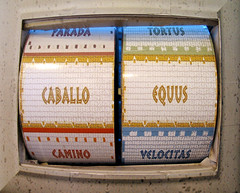For my original post about the myths, look here.

Myth #6 is this:
Students learn vocabulary in long lists of isolated words (or, we just went over bosque, why can’t they remember it and remember it’s masculine?).
What a mistake I used to make, and textbooks make. To think that we can give students a list of vocabulary, tell them there’s a quiz on Friday, and somehow think they’ll be able to use it next month, or next week for that matter.
Here’s the truth: students learn words they need to do what they want to do. Think about the words you know – they are words you need to accomplish something. I don’t know how to talk in Spanish about nuclear power plants. I barely know how to talk in English about nuclear power plants, and what I do know I know because my father worked at one for thirty years. Our brains are efficient – most of us just don’t bother remembering terminology we never need to communicate something.
If you’ve interacted with me for very long, you know that my students do free-topic blogging. I once had a student who wrote nearly every week about hunting. It was his passion. The verb cazar was not in our vocabulary for Spanish 3. But you can bet that before long he knew that and the words for all the different animals he hunted. Why? Because he wanted to. In Spanish 3 every year, we read the novels Cajas de cartón and Esperanza renace. Both deal with immigrant children. Though the words are not in our vocabulary list, by the end of the year they are completely familiar with words like migra, campesino, pizcar, and frontera. Why? Because they need them to talk about the issues in the books.
It’s one of the most freeing things that has ever happened to me in my professional life to come to the realization that students will naturally acquire the vocabulary that interests and helps them without me drilling or quizzing it.
As a few resources for you, check out the archive of last year’s #Langchat on rethinking how we teach vocabulary. I also have done several blog posts on this topic, including how I do vocabulary (surprise! I do give out vocab lists!), why you should kick the vocab quiz, and what you might do instead of the vocab quiz. Also check out cybraryman‘s page on teaching vocabulary, as well as Edutopia‘s insightful post on the topic.
If you’re into research, read up on what it has to tell us about teaching vocabulary, including that shallow processing memorization doesn’t work. For a tempering opinion, if it’s worth a book purchase to you, you could read Vocabulary Myths by Keith Folse, who warns that throwing out vocab lists and stopping teaching it explicitly is too dramatic and not actually an answer to the vocab question.
However you decide to present and teach and review your vocabulary, my advice is to seek more ways to focus on these five keys:
1) motivation – make it vocabulary students find interesting.
2) useful – students see value in vocabulary when they can see themselves using it.
3) frequency – in every way you can think of, integrate the vocabulary that everyone uses.
4) phrasal – fool with words and phrases to encourage chunking of words commonly used together
5) less is more – concede that students can only acquire so much at a time, and give up on the rest (at least until later).
Photo credit: Micheo
5 Comments
Comments are closed.




So, I give vocabulary for pre-reading to facilitate comprehension. Now I just can't figure out what to do with it. Abandon it when story's over? Hope they work it into their own stories? Give CREDIT for working some into their own stories? Give credit for new vocabulary looked up & applied?
I have been trying to re-do my way of presenting/choosing/assessing vocab and totally agree. I only learned what was useful to me and if I don't use a word – I will forget it! My problem is that the teacher ahead of me is stuck to the lists and expects all the kids to know every word from their Sp 2 book in Sp 3 (and uses them on tests). I can't talk her out of it (trust me, I've tried). So I'm trying to meld the dreaded lists (which I edit) with their own lists. We'll see how it works… In AP I like giving credit when they re-use an old word (either by pointing it out and making a big deal or by adding a point here and there). Use it or lose it is our class motto 🙂
I would say abandon it, because abandoning it isn't actually abandoning it. It's just putting it aside until it comes up again or we need it again, and when that happens enough times, the word is acquired. Yesterday or the day before we had the verb 'enterarse de' twice in back-to-back sources, one print and one audio. So we wrote it on the board in the different forms in which it was used and examined them a bit. I feel like something about that triggers in their heads, 'hey, this is pretty common, I might need this.'
Another example – I have one AP student who can already use darse cuenta de que (one of our top target phrases for the whole year) — because it's in her Harry Potter Spanish translation she's reading. 🙂
@Traciepod thanks for the comment, I hope you can win your colleague over. Has she been to a conference or would she be willing to go?
Did my comment not post? Darn it.
I was reading your post on "free blogging" and I had some questions about how you do it. How do you set up a blog so that just the students can see it and post without being seen by the rest of the internet?
And thank you for this blog. I love reading your posts which give me new ideas and insight to my teaching methods. I'm about to start my second year of teaching and am hoping to incorporate more of your ideas so that my students are more proficient in Spanish.
Hi Laura, I got both your comments, thanks. 🙂 I used to use Blogger for our blog. They will let you set the blog to be viewable only by authorized readers or authors. When someone hits the blog, they see "You aren't authorized to view this blog. Please sign in." or something like that. They also let you set it so that it never comes up on the "next blog" function on blogspot's home page. And I gave each one a name that was a combination of our school name, the level of Spanish, and what period they met, so that the likelihood anyone would accidentally land on the front page would be infinitely small. That worked well – I used the permissions function to email each student an invite to be an author, they accepted it and were able to post whenever they wanted, and the post would tell me who wrote it and when.
This year we are using Edmodo. The students are liking it a lot because it's so much like facebook. It literally looks like a Facebook wall. The students get a secret code that allows them into our Spanish 3 or AP Spanish group. Also, a group of us have created a group called AmigoWeb for students to collaborate among schools. Let me know if you want to hang out with us there!